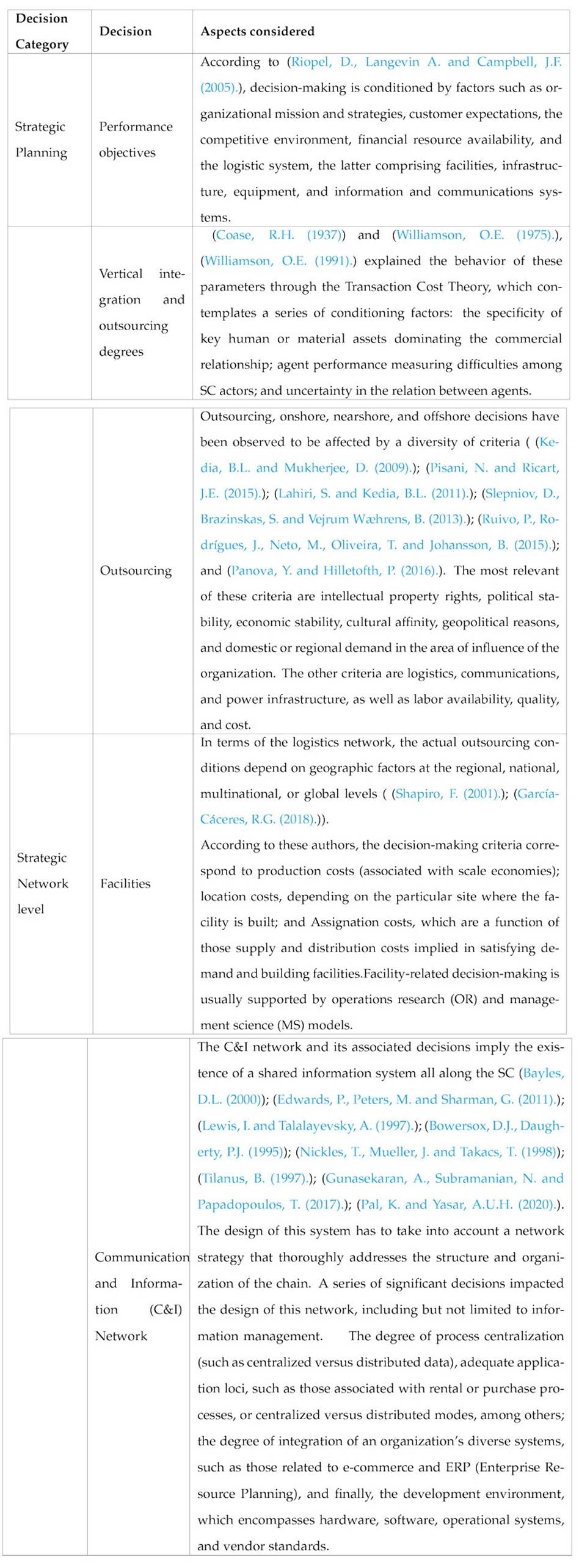INTRODUCTION
The evaluation of the characterization of a Supply Chain constitutes one of its basic management needs. According to (Strauss, A. and Corbin, J. (2014).), the characterization of an object corresponds to its organized description, as a probable first step in the systematization of an experience. The characterization is based on exhaustive documentation of the phenomenon in question, from its origins in the past to its current condition.
This work is supported by the systematic literature review ((Xiao, Y. and Watson, M. (2019).), whose deployment is presented below.
Search The Literature
The literature on the topic shows a number of works that have tackled SC characterization, most of them focusing on tactical aspects. In some of these cases, not only is the scope of the decision level unclear, but an adequate theoretical paradigm is also lacking. Table 1 is a summary of some of these works, with an emphasis on the decision levels they address.
A clearly strategic approach to the SC has been developed by (García-Cáceres, R.G. and Olaya, E.S. (2006).), (García-Cáceres, R.G., Torres-V. S., Olaya-E, E.S., Díaz-G, H.B., Vallejo-D. M.R. and Castro-S., H.F. (2009).), (García-Cáceres, R.G., Núñez-Moreno, A., Ramírez-Ortiz, T. and Jaimes-Suárez, S.(2013).), (García-Cáceres, R.G., Perdomo, A., Ortiz, O., Beltrán, P. and López. K. (2014).), (López-Ramírez, C.A. and García-Cáceres R.G. (2020) .), and (Martinez-Albarracín, K.D., Rivera-Roncancio, L.M. and García-Cáceres, R.G. (2019) .) paying special attention to network decisions. This body of work intends to feature SCs in the context of local and international markets, especially in terms of facility network structure and agent identification, roles, and relationships. In turn, in turn, (Torres, S and García-Cáceres, R.G. (2008)) have addressed SC organization and governance forms about outsourcing and vertical integration. (Stephens, S. (2001) .) has characterized SC processes, while (Lambert, D.M., Cooper, M.C. and Pagh, J.D. (1998) .), (Lambert, D.M. and Cooper, M.C. (2000).), and (Lambert, D.M. and Enz, M.G. (2017).) have studied SC facility deployment. Therefore, the current review of the literature reveals that none of the available CS characterization studies have focused on the selection of decisions mentioned in (Riopel, D., Langevin A. and Campbell, J.F. (2005) .) and (Campbell, D. and Craig, T. (2005) ). In this context, this article develops a holistic conceptual framework for the characterization of strategic CS decisions
EXTRACTING DATA
Methodological proposal
In approaching SC decisions and relationships at the strategic and tactical levels, (Riopel, D., LangevinA. and Campbell, J.F. (2005) .) found five strategic decisions taking place in a hierarchical structure comprising two levels. In turn, (García-Cáceres, R.G. and Olaya, E.S. (2006) .) have characterized SC problems and their interaction with SC decisions. These works provide a rigorous description of the context surrounding SC characterization, the strategic aspects of which constitute the focus of the present work. Table 2 sets out the strategic decisions of the SC and the aspects considered under each of them context surrounding SC characterization, the strategic aspects of which constitute the focus of the present work. Table 2 sets out the strategic decisions of the SC and the aspects considered under each of them
The strategic decisions explained in Table 2 are related to each other by a nested hierarchy ((Riopel, D., Langevin A. and Campbell, J.F. (2005) .), which, in turn, impacts tactical decisions. The top levels of this hierarchy can be seen at the top of the table, while the lower levels can be seen at the bottom. According to the literature review, the only strategic planning processes supported by a theoretical background are those based on the Economic Theory of Transaction Costs. Otherwise, the decision-selection processes found in the literature are based on SCM.
ANALYSING AND SYNTHESIZING DATA
The current SC characterization framework details the strategic decisions in question, which it couples to the SC strategic characterization structure. This framework identifies the relevant features that need to be characterized and embeds them in a hierarchical decision structure. The SC strategic characterization here developed can be seen in Table 3.
REPORT FINDINGS-CONCLUSIONS AND RESEARCH PERSPECTIVES
The present work resulted from the discovery of a research gap related to the lack of adequate methodologies to support the selection of strategic decisions. Since it is aimed at decision-makers, some usage guidelines deserve attention: the strategic decisions themselves and their characteristics, and the actual supply chain characterization framework, which provides decision-makers with a holistic view of the competitors in the chain.
An attractive prospect of future research could also encompass tactical decisions along with current strategic ones


















